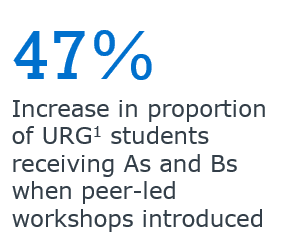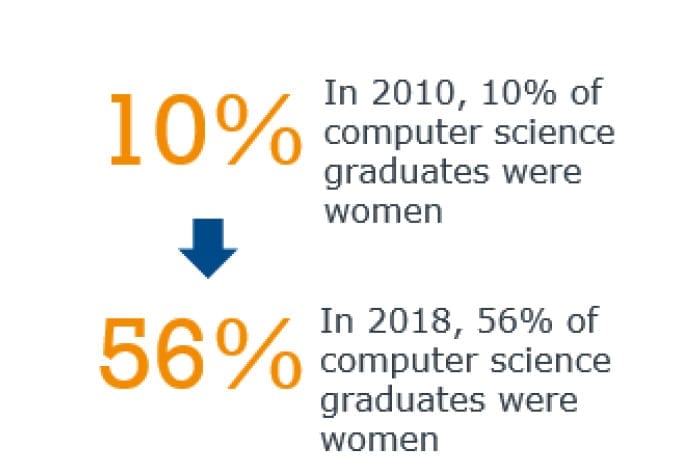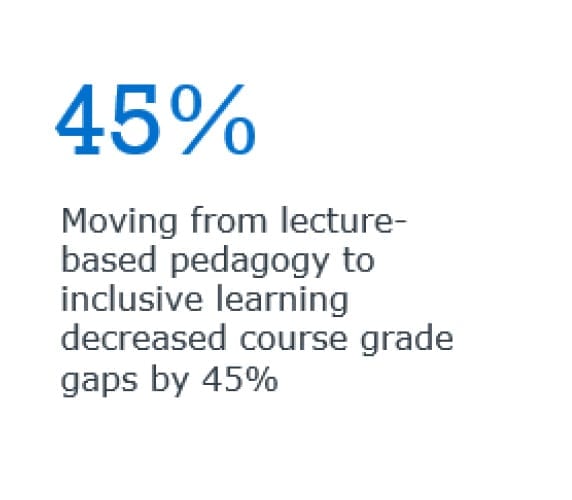Why–and how–to build a sense of belonging on campus
A growing body of research, including EAB’s own this past year, tells us that students’ sense of belonging on campus is crucial not only for student success and persistence, but for student equity. Feeling respected, welcomed, and valued is correlated with outcomes like higher grades, retention, and engagement. Yet demographic disparities in these outcomes remain, caused in part by lower reported senses of safety and belonging.
Many colleges struggle to make significant improvements in these aspects of the student experience, and they tend to rely solely on broad student affairs initiatives like anti-bias training or encouraging extracurricular engagement. However, campuses often overlook the ways that academic structures can improve students’ sense of belonging on campus, in their majors, and in their classrooms.
Bias incidents at the forefront of our minds
Over the past few years, issues of belongingness and equity have been ever-present in higher education news. From incidents of blackface to confederate statues and sexual assault, it is clear that inclusion will continue to be a pressing campus issue.
Some colleges are even facing what has been coined “The Mizzou Effect” when campuses that experience high-profile bias incidents struggle to recruit and retain students. Meanwhile, HBCUs and women’s colleges have seen an enrollment boost, largely attributed to the welcoming community these campuses can provide for students.
Embedding peer mentors in academic experiences enhances sense of inclusion
 Many campuses use peer support to help foster a sense of belonging on campus. Oftentimes, students face a trust barrier when working with faculty and professional staff members, sometimes as a result of a history of fraught relationships with authority figures. Peers, however, overcome this barrier because students are eager to connect with and learn from one another. While students may be nervous or ashamed to reach out to a faculty or staff member, students tend to find peers more approachable and easier to connect with, which can be especially beneficial to women and students of color.
Many campuses use peer support to help foster a sense of belonging on campus. Oftentimes, students face a trust barrier when working with faculty and professional staff members, sometimes as a result of a history of fraught relationships with authority figures. Peers, however, overcome this barrier because students are eager to connect with and learn from one another. While students may be nervous or ashamed to reach out to a faculty or staff member, students tend to find peers more approachable and easier to connect with, which can be especially beneficial to women and students of color.
For more information on peer support, check out our on-demand webconference, and stay tuned for a forthcoming peer support resource guide.
Harvey Mudd fosters a welcoming environment in computer science
Sense of belonging also matters for students’ persistence within a major. Research shows that women leave STEM majors at higher rates than men, and that Latinx and Black students leave STEM majors at higher rates than white students. The researchers hypothesize that these students face stereotypes that contribute to feelings of exclusion.
 Harvey Mudd College redesigned their introductory computer science course to be more welcoming to students without previous coding experience. Previously, when grouped together, students without coding experience lost confidence in their abilities when students with coding experience would dominate class conversations. In their redesigned course, Harvey Mudd offers separate sections, all of which follow the same content, for students with coding experience and for those without. As a result, in 2018, women comprised 56% of computer science graduates, up from 10% of graduates in 2010.
Harvey Mudd College redesigned their introductory computer science course to be more welcoming to students without previous coding experience. Previously, when grouped together, students without coding experience lost confidence in their abilities when students with coding experience would dominate class conversations. In their redesigned course, Harvey Mudd offers separate sections, all of which follow the same content, for students with coding experience and for those without. As a result, in 2018, women comprised 56% of computer science graduates, up from 10% of graduates in 2010.
Classroom practices impact student equity in the classroom
 Faculty can influence sense of belonging in the classroom with a profound impact on student equity. Dr. Kelly Hogan, Assistant Dean of Instructional Innovation and Professor at University of North Carolina’s College of Arts and Sciences, completed research showing how inclusive pedagogy can help narrow student achievement gaps in Biology 101.
Faculty can influence sense of belonging in the classroom with a profound impact on student equity. Dr. Kelly Hogan, Assistant Dean of Instructional Innovation and Professor at University of North Carolina’s College of Arts and Sciences, completed research showing how inclusive pedagogy can help narrow student achievement gaps in Biology 101.
After learning that Black and Latinx students had higher DFW rates than their white peers, Dr. Hogan changed the way she taught to make it more inclusive. Dr. Hogan flipped her classroom, meaning that students now spend more time outside of class engaged with instructional content, and more time in class on activities and group discussion. She also increased transparency and structure so that students have a clear idea of how to navigate the course and of what work they need to do before, during, and after class. Additionally, Dr. Hogan uses inclusive techniques for facilitating class discussion in order to encourage participation from all students.
With student success and student equity on top of many campus agendas, campus leaders should cultivate a sense of belonging among all students. Stay tuned for more resources stemming from our research on overcoming barriers to equity including a peer mentoring resource center and an audit of barriers to student success.
Learn more about our equity research with our article, 5 surprising indicators of student success disparities.